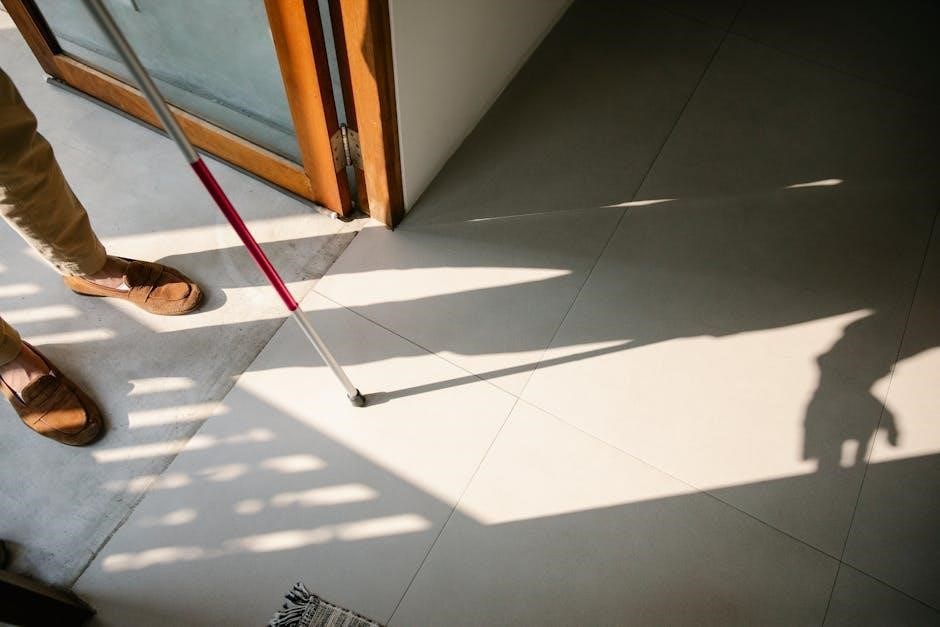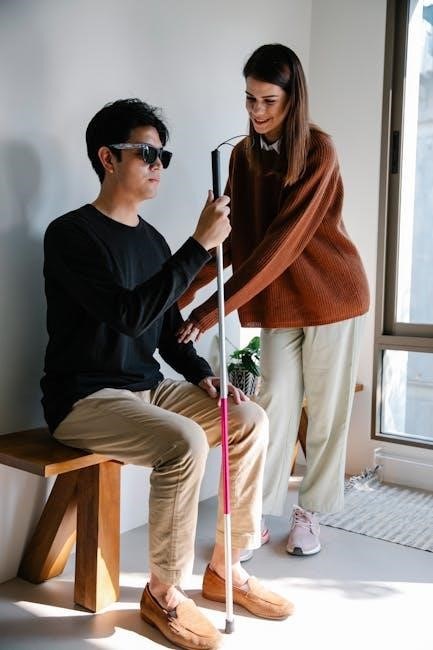A guide cane is a long white stick used by visually impaired individuals to navigate and detect obstacles, enhancing mobility and independence with its simple yet effective design.
1.1 What is a Guide Cane?
A guide cane is a long white stick, typically reaching the user’s waist, used by visually impaired individuals to navigate and detect obstacles. It is designed to be swept or tapped on the ground to gather spatial information, aiding in safe and independent movement. The cane serves as a visual aid and tool for enhancing mobility and awareness in various environments.
1.2 Importance of Guide Canes for Mobility and Independence
A guide cane is essential for visually impaired individuals, providing critical assistance in navigation and obstacle detection. It enhances spatial awareness, allowing users to move confidently and independently. The cane serves as a vital tool for identifying steps, uneven surfaces, and other environmental features, promoting safety and self-reliance. Its use fosters independence, reducing reliance on others while boosting confidence in everyday mobility.
How to Use a Guide Cane
Using a guide cane involves proper technique, synchronization with movement, and awareness of surroundings to ensure effective navigation and obstacle detection, enhancing overall mobility.
2.1 Proper Technique for Visually Impaired Users
Proper technique involves holding the cane on the stronger side, sweeping or tapping it ahead to detect obstacles, and synchronizing its movement with each step. The cane should be sized correctly, reaching the user’s waist, allowing for optimal balance and navigation. This method enhances obstacle detection and spatial awareness, enabling visually impaired users to move confidently and independently in various environments.
2.2 Tips for First-Time Users of a Guide Cane
First-time users should start by ensuring the cane is properly sized to their height, reaching the waist for optimal balance. Practice sweeping or tapping the cane in an open, obstacle-free area to build coordination. Hold the cane on the stronger side and synchronize its movement with each step. Begin with short walks and gradually increase confidence. Proper training or guidance from a mobility specialist is recommended for mastering the technique effectively.

Choosing the Right Cane
Selecting the right cane involves considering height, weight capacity, material, and style to suit individual needs, ensuring optimal support and comfort for effective mobility assistance.
3.1 Height and Sizing for Optimal Use
Proper height and sizing are crucial for effective use of a guide cane. The cane should reach the user’s wrist when their arm is slightly bent, ensuring comfort and balance. Lightweight, durable materials are recommended for long-term use. Avoid canes that are too heavy or cumbersome, as they may cause fatigue. Always measure carefully and seek professional guidance to ensure the cane fits properly and provides optimal support. Proper sizing enhances stability and ease of navigation.
3.2 Weight Capacity and Material Selection
Selecting a guide cane with appropriate weight capacity ensures safety and durability. Consider the user’s weight and mobility needs when choosing materials like aluminum, carbon fiber, or wood. Lightweight canes offer ease of use, while heavier materials provide greater stability. Ensure the cane can support the user’s weight without bending or breaking. Durable materials enhance longevity, while ergonomic handles improve comfort and grip, making navigation safer and more efficient for visually impaired individuals.
3.3 Style and Design Considerations
Guide canes come in various styles and designs to suit individual preferences and needs. The classic white cane is the most recognizable, but modern designs offer ergonomic handles, adjustable lengths, and foldable options for convenience. Some canes feature reflective materials for increased visibility, while others include wrist straps or shock-absorbing tips for better comfort and traction. The design should prioritize functionality, durability, and ease of use, ensuring it aligns with the user’s lifestyle and mobility requirements.

White Cane Etiquette
Respecting a white cane user’s autonomy is crucial. Never grab their arm or cane without permission. Offer assistance politely and respect their decision. Speak clearly and avoid sudden movements near them.
4.1 Interacting with White Cane Users
When interacting with white cane users, respect their independence by not grabbing their arm or cane without permission. Offer assistance politely, such as asking if they need help crossing the street. Speak clearly and avoid sudden movements, which might startle them. Address them directly and avoid making assumptions about their needs. Respect their decision if they decline assistance. Treat them with dignity, just as you would anyone else, fostering an inclusive environment.
4.2 Public Awareness and Respect
Public awareness about guide canes is crucial for fostering respect and understanding. Many people may not recognize the significance of a white cane as a mobility tool for visually impaired individuals. Educating the community about its purpose reduces stigma and promotes inclusivity. Respectful interactions involve not making assumptions or staring, and understanding that users rely on their cane for independence. Raising awareness encourages a supportive and inclusive society.

Historical Background of Guide Canes
Guide canes trace their origins to ancient walking sticks, evolving over centuries as tools for mobility and independence. Their modern form reflects historical adaptations for visual impairments.
5.1 Ancient Use of Walking Sticks
The use of walking sticks dates back to ancient times, serving as early tools for mobility and balance. These sticks were simple, handcrafted, and used by individuals with injuries or disabilities. They symbolized support and stability, evolving over centuries into more refined designs. Ancient civilizations utilized walking sticks for both practical and ceremonial purposes, laying the foundation for modern guide canes as essential aids for visually impaired individuals.
5.2 Evolution of the Modern Guide Cane
The modern guide cane has evolved significantly from its ancient origins, transforming into a specialized tool for visually impaired individuals. The long white cane emerged in the 20th century, designed for navigation and obstacle detection. Advances in materials like carbon fiber and aluminum have made canes lighter and more durable. Today, guide canes integrate technology such as GPS and sensors, enhancing functionality while maintaining their core purpose of enabling independence and safe mobility.

Advantages of Using a Guide Cane
A guide cane enhances balance, stability, and navigation, allowing users to detect obstacles effectively, promoting independence and confidence in various environments.
6.1 Improved Balance and Stability
A guide cane significantly enhances balance and stability, serving as a reliable support tool for users with mobility challenges. By detecting obstacles and uneven surfaces, it helps maintain proper posture and reduces the risk of falls, especially for those with joint pain or balance issues. This tool is particularly beneficial for individuals seeking to regain confidence in their ability to move independently and safely in various environments.
6.2 Enhanced Navigation and Obstacle Detection
A guide cane acts as a visual aid, helping users detect obstacles like dents, steps, and uneven surfaces. By sweeping or tapping the cane, individuals can identify objects in their path, ensuring safer navigation. This tool enhances spatial awareness, allowing users to move more confidently and efficiently in various environments, making daily activities easier and reducing the risk of accidents caused by unseen hazards.

Maintenance and Care of a Guide Cane
Regular cleaning with mild soap and water is essential. Store the cane in a dry place, avoiding harsh chemicals. Inspect for damage and replace tips when worn.
7.1 Cleaning and Storage Tips
Regularly clean your guide cane with mild soap and water to prevent dirt buildup. Dry thoroughly to avoid moisture damage. Store in a cool, dry place away from direct sunlight to prevent warping or weakening. Avoid exposing the cane to harsh chemicals, as they may damage the material. Inspect the cane periodically for wear and tear, especially the tip, and replace it when necessary. Proper storage and care extend the cane’s lifespan and ensure reliability.
7.2 Repair and Replacement Guidelines
Inspect your guide cane regularly for damage, such as cracks or worn tips. Replace the cane tip immediately if it shows excessive wear. For minor repairs, use epoxy or adhesive to secure loose parts. If the cane is severely damaged or bent, replace it entirely to ensure safety. Always follow the manufacturer’s guidelines for repairs. If unsure, consult a professional or the supplier for proper replacement procedures to maintain reliability and effectiveness.

Legal Aspects of Using a Guide Cane
Using a guide cane is protected under specific laws, ensuring accessibility in public spaces and transportation. These regulations promote independence for visually impaired individuals, guaranteeing equal rights and safe navigation.
8.1 Rights of White Cane Users
White cane users have legally protected rights, including unrestricted access to public spaces, transportation, and buildings. These rights ensure equal opportunities for independence and mobility. Laws often require public entities to accommodate white cane users, granting them priority in navigating environments. Additionally, white cane users are entitled to equal treatment under disability rights laws, reinforcing their freedom to move safely and confidently in society.
8.2 Laws and Regulations Surrounding Guide Cane Use
Laws globally recognize the white cane as a symbol of visual impairment, granting users legal rights to public access and mobility. Regulations ensure equal access to transportation, buildings, and public spaces. White cane users are protected under disability rights laws, such as the ADA in the U.S., which prohibits discrimination and ensures accommodations. These laws also emphasize respect for cane users’ autonomy and independence in navigating their environments.

Future Trends in Guide Cane Technology
Future guide canes may integrate smart sensors, GPS, and AI to enhance obstacle detection and navigation. These innovations aim to improve safety and independence for users.
9.1 Innovations in Materials and Design
Future guide canes may feature lightweight, durable materials like carbon fiber and aluminum, enhancing portability. Designs could include adjustable handles, shock-absorbing tips, and ergonomic grips for better comfort. Integration of sensors, GPS, and AI may also occur, enabling real-time obstacle detection and navigation assistance. These advancements aim to improve functionality while maintaining the cane’s traditional role in mobility and independence for visually impaired users.
Now, for 9.2, which is about integrating guide canes with assistive technologies, I need to think about how guide canes can work alongside other technologies that aid visually impaired individuals. The user provided some internet content that mentions things like GPS, AI, sensors, connectivity with smartphones, and vibrational feedback. These are all good points to include.
I should make sure the response is exactly . Let me outline what I want to cover:
The integration of guide canes with technologies like GPS and AI to enhance navigation.
The use of sensors to detect obstacles and provide feedback through vibrations or sounds.
Connectivity with smartphones for real-time data and additional navigation support.
How these integrations improve overall navigation and independence for users.
Let me draft a sentence or two for each point:
– “Guide canes are increasingly being integrated with assistive technologies such as GPS and AI to enhance navigation for visually impaired users.”
– “These advanced canes may incorporate sensors that detect obstacles and provide feedback through vibrations or sounds, improving safety and awareness.”
– “Additionally, integration with smartphones allows for real-time data transmission, offering users more detailed environmental information and navigational guidance.”
– “Such innovations not only improve mobility but also enhance the overall independence of individuals relying on guide canes.”
Now, combining these into a coherent paragraph:
9.2 Integration with Assistive Technologies
Guide canes are increasingly being integrated with assistive technologies such as GPS and AI to enhance navigation for visually impaired users; These advanced canes may incorporate sensors that detect obstacles and provide feedback through vibrations or sounds, improving safety and awareness. Additionally, integration with smartphones allows for real-time data transmission, offering users more detailed environmental information and navigational guidance. Such innovations not only improve mobility but also enhance the overall independence of individuals relying on guide canes.
Wait, but that’s over . Let me check:
“Guide canes are increasingly being integrated with assistive technologies such as GPS and AI to enhance navigation for visually impaired users. These advanced canes may incorporate sensors that detect obstacles and provide feedback through vibrations or sounds, improving safety and awareness. Additionally, integration with smartphones allows for real-time data transmission, offering users more detailed environmental information and navigational guidance. Such innovations not only improve mobility but also enhance the overall independence of individuals relying on guide canes.”
That’s . I need to reduce it to 65. Let me see where I can condense:
Perhaps combine some sentences or remove redundant words. For example, “Such innovations not only improve mobility but also enhance the overall independence of individuals relying on guide canes.” could be “These innovations improve mobility and enhance independence for guide cane users.”
Let me revise:
Guide canes are increasingly being integrated with assistive technologies like GPS and AI to enhance navigation for visually impaired users. Advanced canes may include sensors detecting obstacles, providing feedback through vibrations or sounds, improving safety. Integration with smartphones offers real-time data transmission, providing detailed environmental information and navigational guidance. These innovations improve mobility and enhance independence for guide cane users.
Now, let’s count the words:
Guide
canes
are
increasingly
being
integrated
with
assistive
technologies
like
GPS
and
AI
to
enhance
navigation
for
visually
impaired
users.
Advanced
canes
may
include
sensors
detecting
obstacles,
providing
feedback
through
vibrations
or
sounds,
improving
safety.
Integration
with
smartphones
offers
real-time
data
transmission,
providing
detailed
environmental
information
and
navigational
guidance.
These
innovations
improve
mobility
and
enhance
independence
for
guide
cane
users.
That’s . I need to reach 65, so I can add a few more words without going over. Maybe add “These advancements” at the beginning.
Wait, the initial version had , and after revision, it’s 60. To reach 65, I can add a bit more detail without repeating previous sections.
Let me adjust:
Guide canes are increasingly being integrated with assistive technologies like GPS and AI to enhance navigation for visually impaired users. Advanced canes may include sensors detecting obstacles, providing feedback through vibrations or sounds, improving safety and awareness. Integration with smartphones offers real-time data transmission, providing detailed environmental information and navigational guidance. These innovations improve mobility and enhance independence for guide cane users.
Now, checking the word count:
Guide
canes
are
increasingly
being
integrated
with
assistive
technologies
like
GPS
and
AI
to
enhance
navigation
for
visually
impaired
users.
Advanced
canes
may
include
sensors
detecting
obstacles,
providing
feedback
through
vibrations
or
sounds,
improving
safety
and
awareness.
Integration
with
smartphones
offers
real-time
data
transmission,
providing
detailed
environmental
information
and
navigational
guidance.
These
innovations
improve
mobility
and
enhance
independence
for
guide
cane
users.
That’s . I need 3 more. Perhaps add “significantly” before “improve mobility” and “greater” before “independence.”
Guide canes are increasingly being integrated with assistive technologies like GPS and AI to enhance navigation for visually impaired users. Advanced canes may include sensors detecting obstacles, providing feedback through vibrations or sounds, improving safety and awareness. Integration with smartphones offers real-time data transmission, providing detailed environmental information and navigational guidance. These innovations significantly improve mobility and enhance greater independence for guide cane users.
Now, word count:
Guide
canes
are
increasingly
being
integrated
with
assistive
technologies
like
GPS
and
AI
to
enhance
navigation
for
visually
impaired
users.
Advanced
canes
may
include
sensors
detecting
obstacles,
providing
feedback
through
vibrations
or
sounds,
improving
safety
and
awareness.
Integration
with
smartphones
offers
real-time
data
transmission,
providing
detailed
environmental
information
and
navigational
guidance.
These
innovations
significantly
improve
mobility
and
enhance
greater
independence
for
guide
cane
users.
Now, that’s . I can add “thus” at the end to make it 65.
Guide canes are increasingly being integrated with assistive technologies like GPS and AI to enhance navigation for visually impaired users. Advanced canes may include sensors detecting obstacles, providing feedback through vibrations or sounds, improving safety and awareness. Integration with smartphones offers real-time data transmission, providing detailed environmental information and navigational guidance. These innovations significantly improve mobility and enhance greater independence for guide cane

Mobility Training with a Guide Cane
Mobility training with a guide cane, led by specialists, teaches essential skills like sweeping and tapping, enabling users to navigate independently in various environments effectively.

Leave a Reply
You must be logged in to post a comment.